1998 OPEL FRONTERA tow
[x] Cancel search: towPage 2164 of 6000
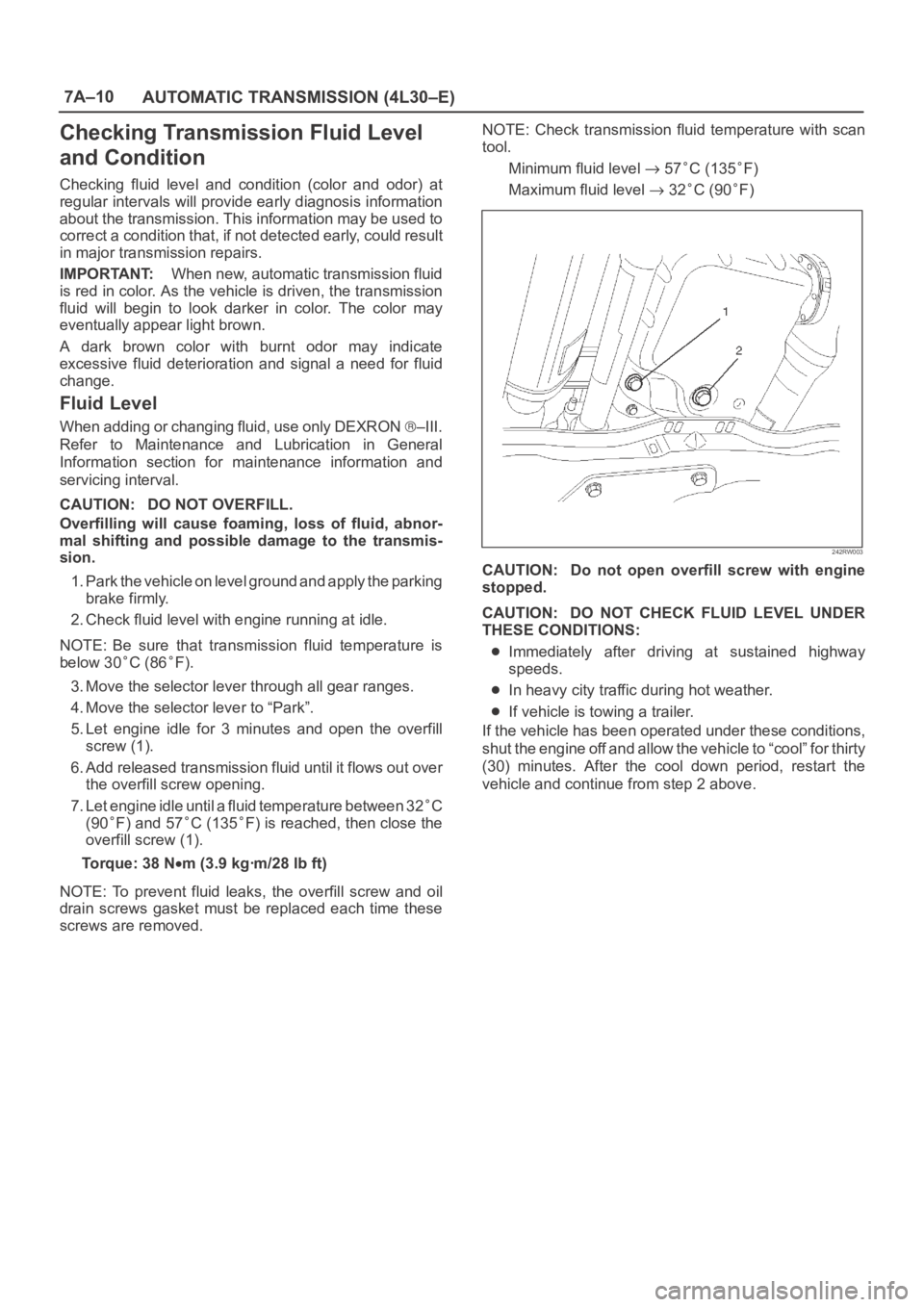
7A–10
AUTOMATIC TRANSMISSION (4L30–E)
Checking Transmission Fluid Level
and Condition
Checking fluid level and condition (color and odor) at
regular intervals will provide early diagnosis information
about the transmission. This information may be used to
correct a condition that, if not detected early, could result
in major transmission repairs.
IMPORTANT:When new, automatic transmission fluid
is red in color. As the vehicle is driven, the transmission
fluid will begin to look darker in color. The color may
eventually appear light brown.
A dark brown color with burnt odor may indicate
excessive fluid deterioration and signal a need for fluid
change.
Fluid Level
When adding or changing fluid, use only DEXRON –III.
Refer to Maintenance and Lubrication in General
Information section for maintenance information and
servicing interval.
CAUTION: DO NOT OVERFILL.
Overfilling will cause foaming, loss of fluid, abnor-
mal shifting and possible damage to the transmis-
sion.
1. Park the vehicle on level ground and apply the parking
brake firmly.
2. Check fluid level with engine running at idle.
NOTE: Be sure that transmission fluid temperature is
below 30
C (86F).
3. Move the selector lever through all gear ranges.
4. Move the selector lever to “Park”.
5. Let engine idle for 3 minutes and open the overfill
screw (1).
6. Add released transmission fluid until it flows out over
the overfill screw opening.
7. Let engine idle until a fluid temperature between 32
C
(90
F) and 57C (135F) is reached, then close the
overfill screw (1).
Torque: 38 N
m (3.9 kgꞏm/28 lb ft)
NOTE: To prevent fluid leaks, the overfill screw and oil
drain screws gasket must be replaced each time these
screws are removed.NOTE: Check transmission fluid temperature with scan
tool.
Minimum fluid level
57C (135F)
Maximum fluid level
32C (90F)
242RW003
CAUTION: Do not open overfill screw with engine
stopped.
CAUTION: DO NOT CHECK FLUID LEVEL UNDER
THESE CONDITIONS:
Immediately after driving at sustained highway
speeds.
In heavy city traffic during hot weather.
If vehicle is towing a trailer.
If the vehicle has been operated under these conditions,
shut the engine off and allow the vehicle to “cool” for thirty
(30) minutes. After the cool down period, restart the
vehicle and continue from step 2 above.
Page 2176 of 6000
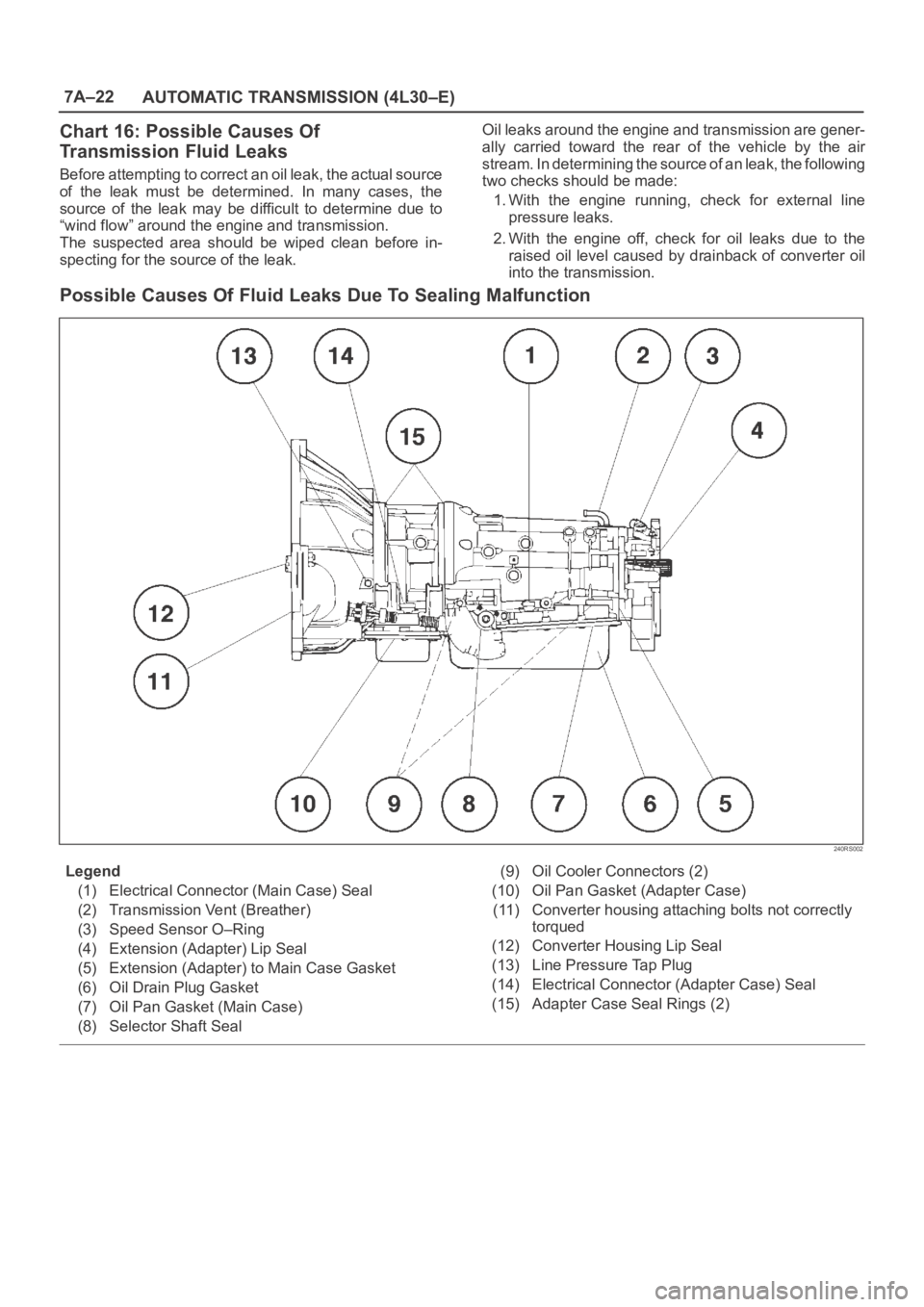
7A–22
AUTOMATIC TRANSMISSION (4L30–E)
Chart 16: Possible Causes Of
Transmission Fluid Leaks
Before attempting to correct an oil leak, the actual source
of the leak must be determined. In many cases, the
source of the leak may be difficult to determine due to
“wind flow” around the engine and transmission.
The suspected area should be wiped clean before in-
specting for the source of the leak.Oil leaks around the engine and transmission are gener-
ally carried toward the rear of the vehicle by the air
stream. In determining the source of an leak, the following
two checks should be made:
1. With the engine running, check for external line
pressure leaks.
2. With the engine off, check for oil leaks due to the
raised oil level caused by drainback of converter oil
into the transmission.
Possible Causes Of Fluid Leaks Due To Sealing Malfunction
240RS002
Legend
(1) Electrical Connector (Main Case) Seal
(2) Transmission Vent (Breather)
(3) Speed Sensor O–Ring
(4) Extension (Adapter) Lip Seal
(5) Extension (Adapter) to Main Case Gasket
(6) Oil Drain Plug Gasket
(7) Oil Pan Gasket (Main Case)
(8) Selector Shaft Seal(9) Oil Cooler Connectors (2)
(10) Oil Pan Gasket (Adapter Case)
(11) Converter housing attaching bolts not correctly
torqued
(12) Converter Housing Lip Seal
(13) Line Pressure Tap Plug
(14) Electrical Connector (Adapter Case) Seal
(15) Adapter Case Seal Rings (2)
Page 2181 of 6000
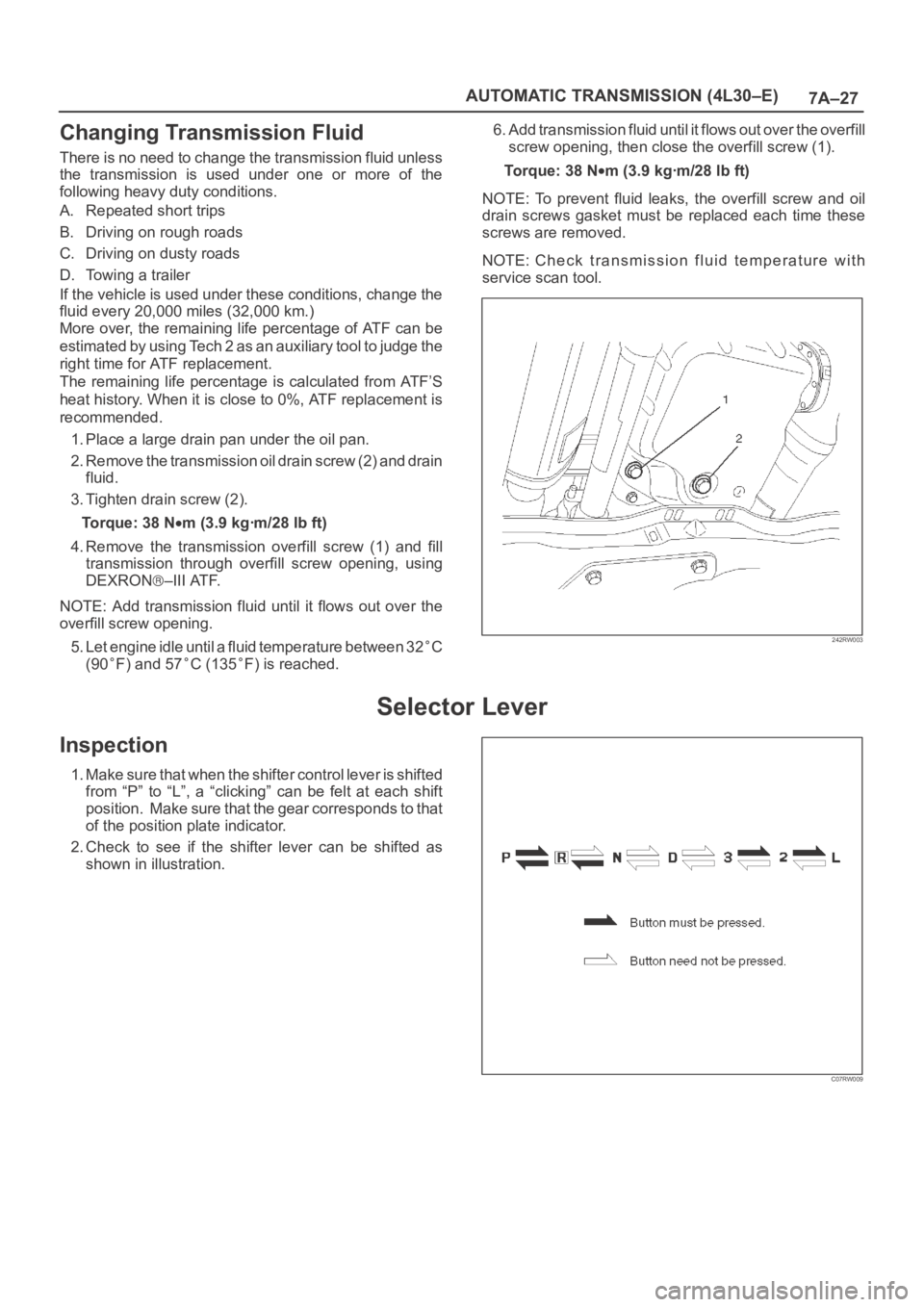
7A–27 AUTOMATIC TRANSMISSION (4L30–E)
Changing Transmission Fluid
There is no need to change the transmission fluid unless
the transmission is used under one or more of the
following heavy duty conditions.
A. Repeated short trips
B. Driving on rough roads
C. Driving on dusty roads
D. Towing a trailer
If the vehicle is used under these conditions, change the
fluid every 20,000 miles (32,000 km.)
More over, the remaining life percentage of ATF can be
estimated by using Tech 2 as an auxiliary tool to judge the
right time for ATF replacement.
The remaining life percentage is calculated from ATF’S
heat history. When it is close to 0%, ATF replacement is
recommended.
1. Place a large drain pan under the oil pan.
2. Remove the transmission oil drain screw (2) and drain
fluid.
3. Tighten drain screw (2).
Torque: 38 N
m (3.9 kgꞏm/28 lb ft)
4. Remove the transmission overfill screw (1) and fill
transmission through overfill screw opening, using
DEXRON
–III ATF.
NOTE: Add transmission fluid until it flows out over the
overfill screw opening.
5. Let engine idle until a fluid temperature between 32
C
(90
F) and 57C (135F) is reached.6. Add transmission fluid until it flows out over the overfill
screw opening, then close the overfill screw (1).
To r q u e : 3 8 N
m (3.9 kgꞏm/28 lb ft)
NOTE: To prevent fluid leaks, the overfill screw and oil
drain screws gasket must be replaced each time these
screws are removed.
NOTE: Check transmission fluid temperature with
service scan tool.
242RW003
Selector Lever
Inspection
1. Make sure that when the shifter control lever is shifted
from “P” to “L”, a “clicking” can be felt at each shift
position. Make sure that the gear corresponds to that
of the position plate indicator.
2. Check to see if the shifter lever can be shifted as
shown in illustration.
C07RW009
Page 2205 of 6000
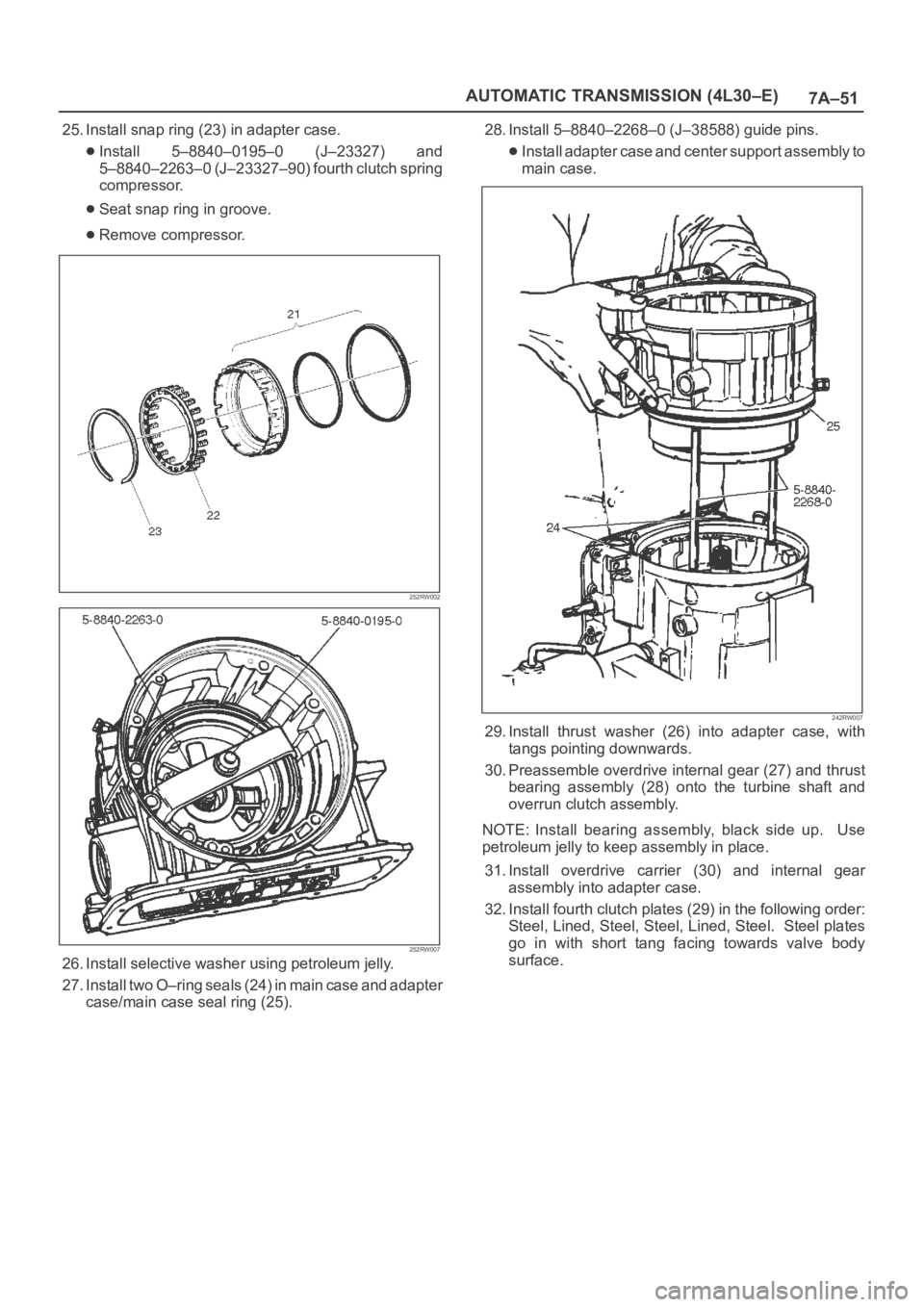
7A–51 AUTOMATIC TRANSMISSION (4L30–E)
25. Install snap ring (23) in adapter case.
Install 5–8840–0195–0 (J–23327) and
5–8840–2263–0 (J–23327–90) fourth clutch spring
compressor.
Seat snap ring in groove.
Remove compressor.
252RW002
252RW007
26. Install selective washer using petroleum jelly.
27. Install two O–ring seals (24) in main case and adapter
case/main case seal ring (25).28. Install 5–8840–2268–0 (J–38588) guide pins.
Install adapter case and center support assembly to
main case.
242RW007
29. Install thrust washer (26) into adapter case, with
tangs pointing downwards.
30. Preassemble overdrive internal gear (27) and thrust
bearing assembly (28) onto the turbine shaft and
overrun clutch assembly.
NOTE: Install bearing assembly, black side up. Use
petroleum jelly to keep assembly in place.
31. Install overdrive carrier (30) and internal gear
assembly into adapter case.
32. Install fourth clutch plates (29) in the following order:
Steel, Lined, Steel, Steel, Lined, Steel. Steel plates
go in with short tang facing towards valve body
surface.
Page 2206 of 6000
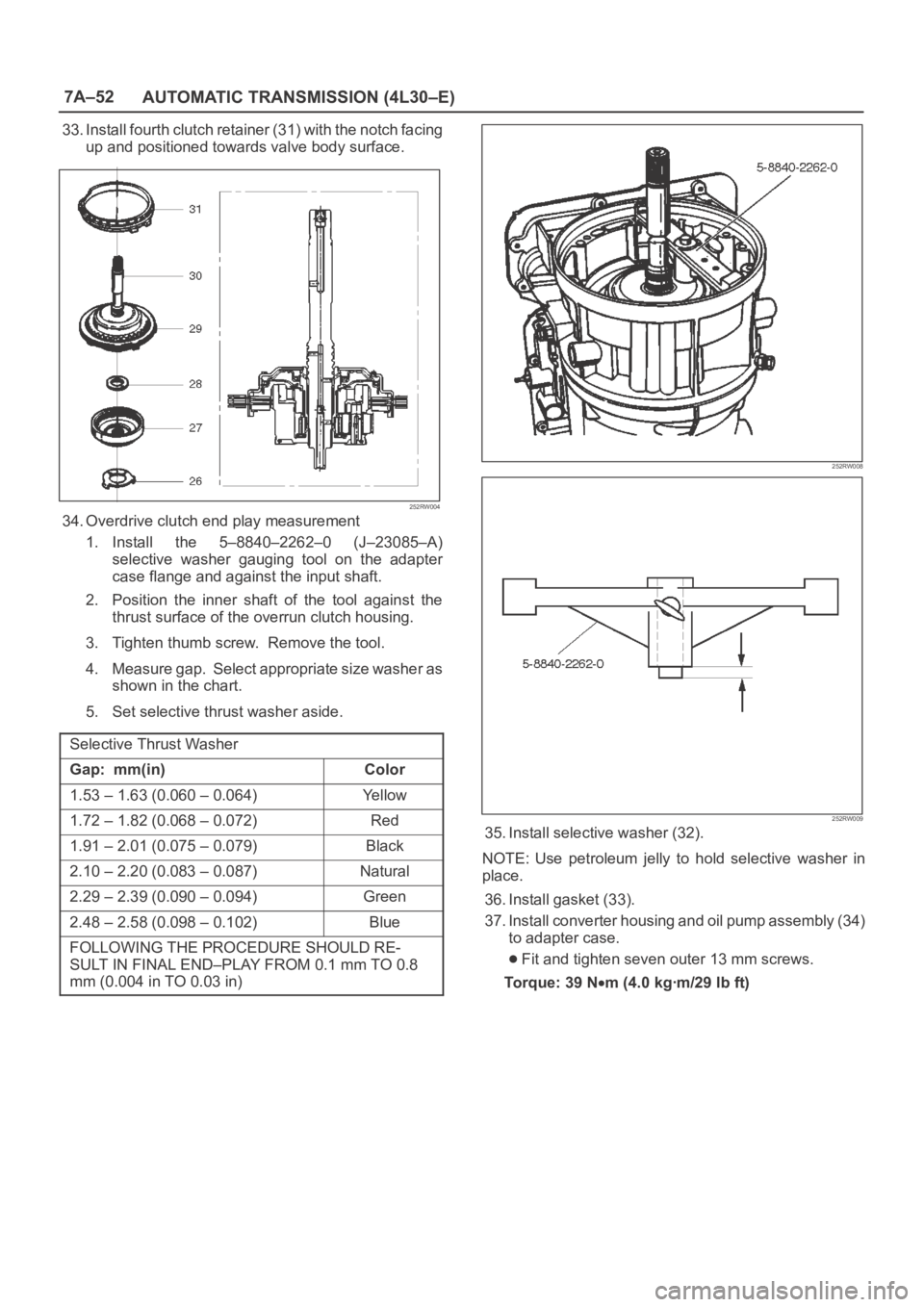
7A–52
AUTOMATIC TRANSMISSION (4L30–E)
33. Install fourth clutch retainer (31) with the notch facing
up and positioned towards valve body surface.
252RW004
34. Overdrive clutch end play measurement
1. Install the 5–8840–2262–0 (J–23085–A)
selective washer gauging tool on the adapter
case flange and against the input shaft.
2. Position the inner shaft of the tool against the
thrust surface of the overrun clutch housing.
3. Tighten thumb screw. Remove the tool.
4. Measure gap. Select appropriate size washer as
shown in the chart.
5. Set selective thrust washer aside.
Selective Thrust Washer
Gap: mm(in)Color
1.53 – 1.63 (0.060 – 0.064)Yellow
1.72 – 1.82 (0.068 – 0.072)Red
1.91 – 2.01 (0.075 – 0.079)Black
2.10 – 2.20 (0.083 – 0.087)Natural
2.29 – 2.39 (0.090 – 0.094)Green
2.48 – 2.58 (0.098 – 0.102)Blue
FOLLOWING THE PROCEDURE SHOULD RE-
SULT IN FINAL END–PLAY FROM 0.1 mm TO 0.8
mm (0.004 in TO 0.03 in)
252RW008
252RW009
35. Install selective washer (32).
NOTE: Use petroleum jelly to hold selective washer in
place.
36. Install gasket (33).
37. Install converter housing and oil pump assembly (34)
to adapter case.
Fit and tighten seven outer 13 mm screws.
To r q u e : 3 9 N
m (4.0 kgꞏm/29 lb ft)
Page 2208 of 6000
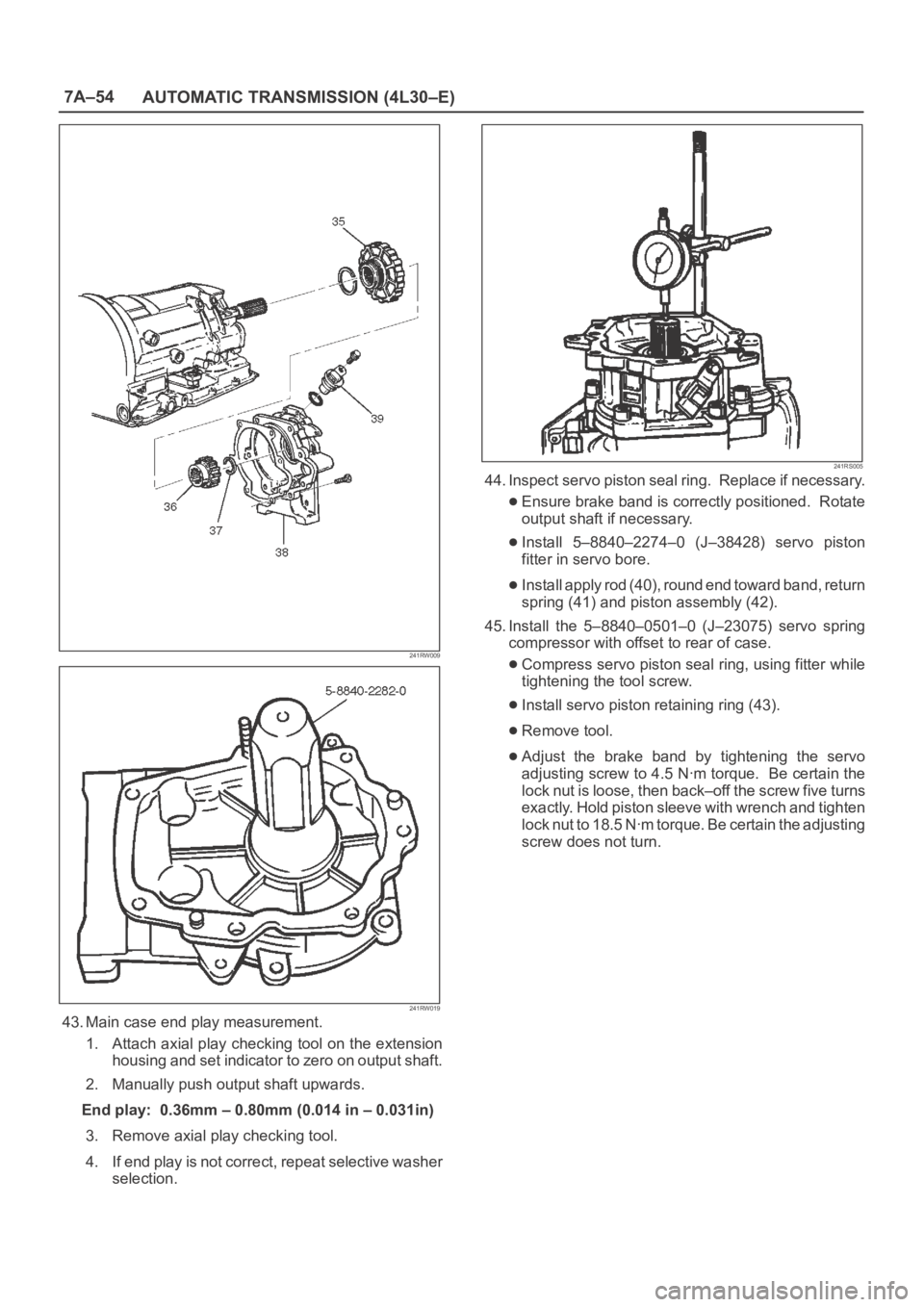
7A–54
AUTOMATIC TRANSMISSION (4L30–E)
241RW009
241RW019
43. Main case end play measurement.
1. Attach axial play checking tool on the extension
housing and set indicator to zero on output shaft.
2. Manually push output shaft upwards.
End play: 0.36mm – 0.80mm (0.014 in – 0.031in)
3. Remove axial play checking tool.
4. If end play is not correct, repeat selective washer
selection.
241RS005
44. Inspect servo piston seal ring. Replace if necessary.
Ensure brake band is correctly positioned. Rotate
output shaft if necessary.
Install 5–8840–2274–0 (J–38428) servo piston
fitter in servo bore.
Install apply rod (40), round end toward band, return
spring (41) and piston assembly (42).
45. Install the 5–8840–0501–0 (J–23075) servo spring
compressor with offset to rear of case.
Compress servo piston seal ring, using fitter while
tightening the tool screw.
Install servo piston retaining ring (43).
Remove tool.
Adjust the brake band by tightening the servo
adjusting screw to 4.5 Nꞏm torque. Be certain the
lock nut is loose, then back–off the screw five turns
exactly. Hold piston sleeve with wrench and tighten
lock nut to 18.5 Nꞏm torque. Be certain the adjusting
screw does not turn.
Page 2216 of 6000
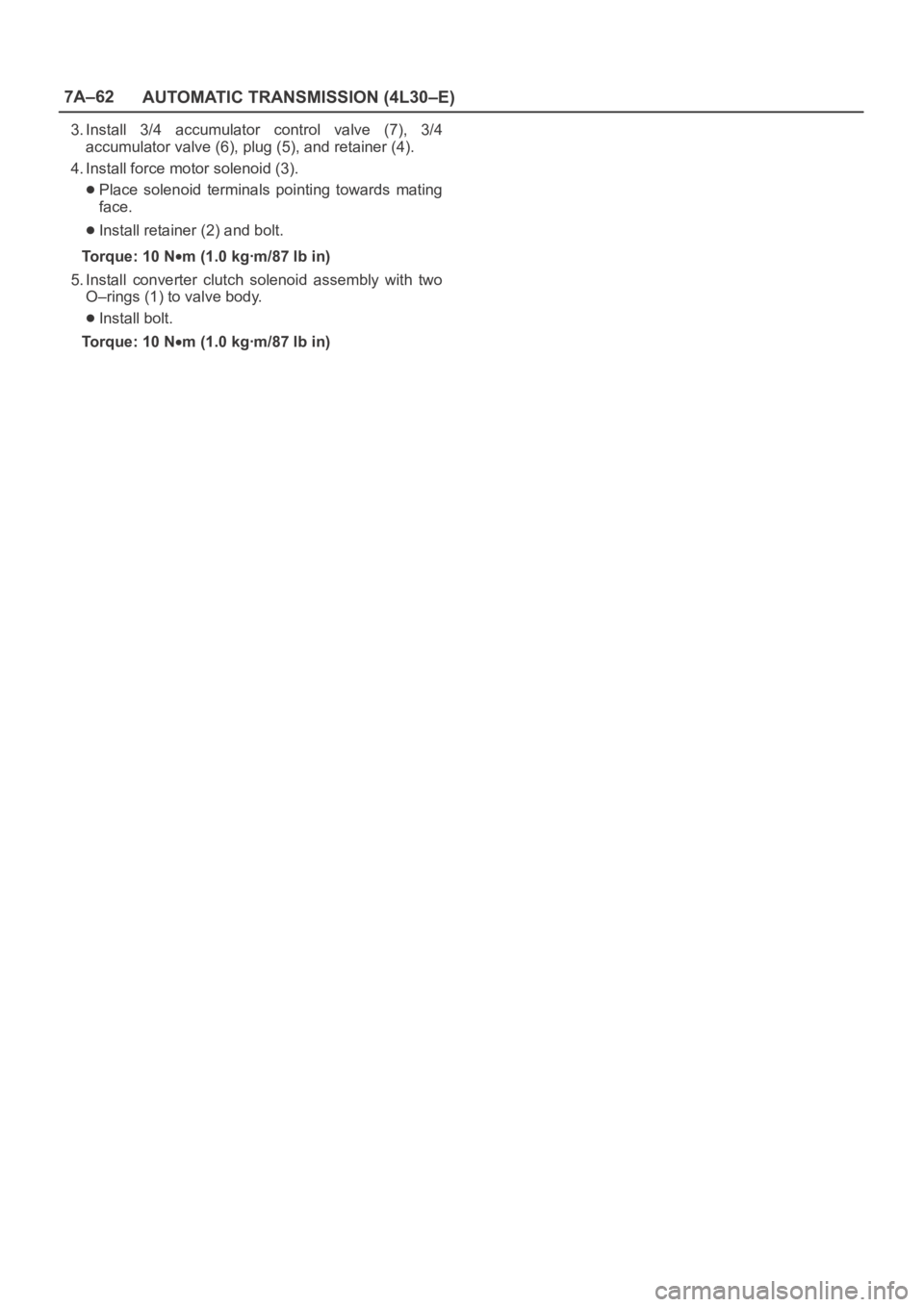
7A–62
AUTOMATIC TRANSMISSION (4L30–E)
3. Install 3/4 accumulator control valve (7), 3/4
accumulator valve (6), plug (5), and retainer (4).
4. Install force motor solenoid (3).
Place solenoid terminals pointing towards mating
face.
Install retainer (2) and bolt.
Torque: 10 N
m (1.0 kgꞏm/87 lb in)
5. Install converter clutch solenoid assembly with two
O–rings (1) to valve body.
Install bolt.
Torque: 10 N
m (1.0 kgꞏm/87 lb in)
Page 2219 of 6000
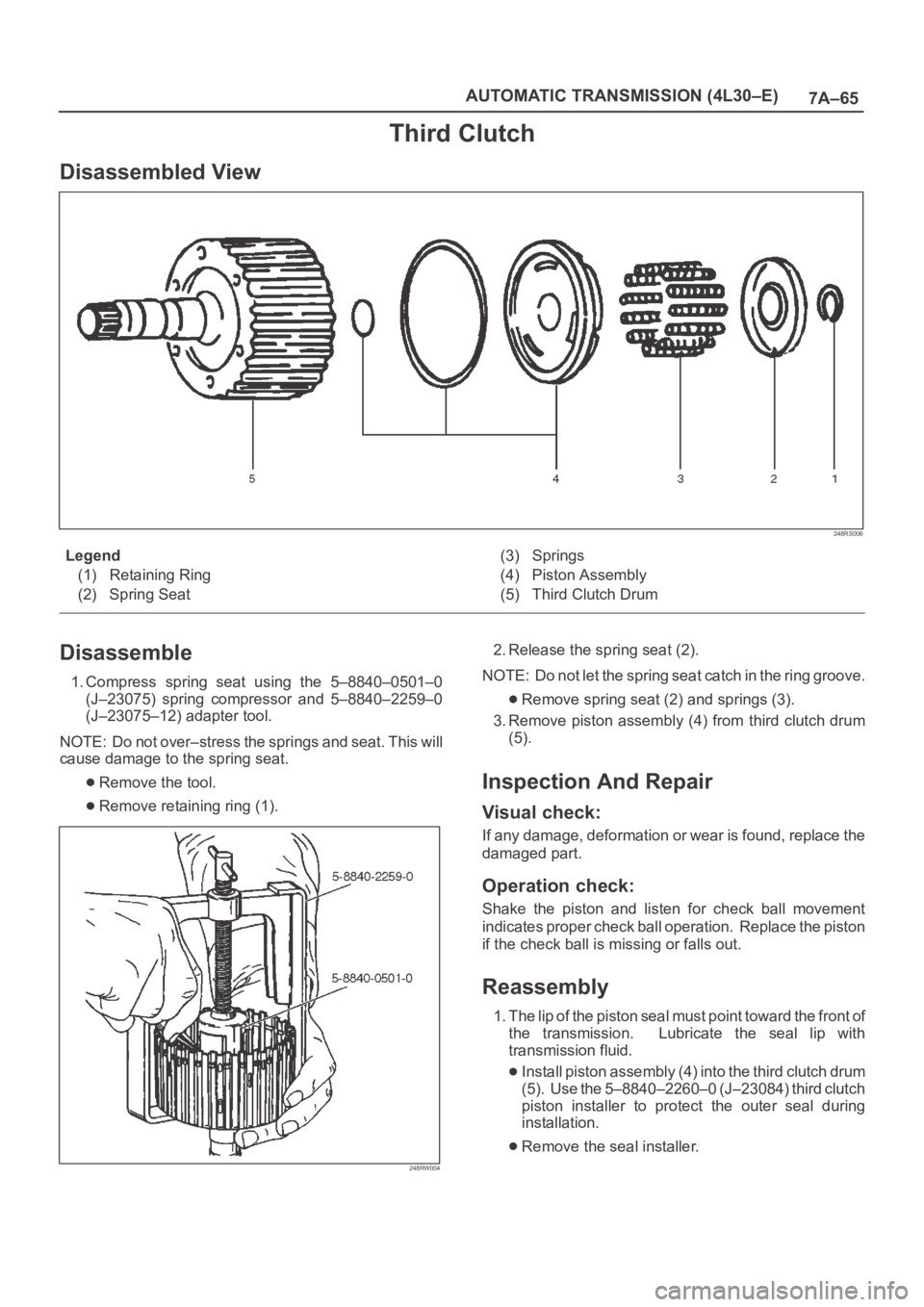
7A–65 AUTOMATIC TRANSMISSION (4L30–E)
Third Clutch
Disassembled View
248RS006
Legend
(1) Retaining Ring
(2) Spring Seat(3) Springs
(4) Piston Assembly
(5) Third Clutch Drum
Disassemble
1. Compress spring seat using the 5–8840–0501–0
(J–23075) spring compressor and 5–8840–2259–0
(J–23075–12) adapter tool.
NOTE: Do not over–stress the springs and seat. This will
cause damage to the spring seat.
Remove the tool.
Remove retaining ring (1).
248RW004
2. Release the spring seat (2).
NOTE: Do not let the spring seat catch in the ring groove.
Remove spring seat (2) and springs (3).
3. Remove piston assembly (4) from third clutch drum
(5).
Inspection And Repair
Visual check:
If any damage, deformation or wear is found, replace the
damaged part.
Operation check:
Shake the piston and listen for check ball movement
indicates proper check ball operation. Replace the piston
if the check ball is missing or falls out.
Reassembly
1. The lip of the piston seal must point toward the front of
the transmission. Lubricate the seal lip with
transmission fluid.
Install piston assembly (4) into the third clutch drum
(5). Use the 5–8840–2260–0 (J–23084) third clutch
piston installer to protect the outer seal during
installation.
Remove the seal installer.